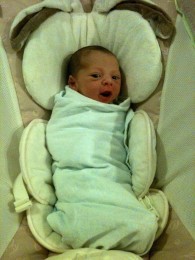Everything You Need to Know About Diapers, Part 1

When Babygirl was born, lo those two very full years ago, I had big ideas about cloth diapers. They’re super cute, but more importantly, they’re better for the environment, better for her, and better for my pocketbook all in one. The cloth diaper sites swear it:
You’ll save money. When you buy disposable diapers, you are throwing away money with each diaper change. Exactly how much you’ll save will vary depending on what brand of disposable diapers you (don’t) purchase and what brand of cloth diapers you choose.
Of course, that logic is a bit suspect. You’re not “throwing money away” when you use disposables anymore than you’re throwing away money when you pay your rent; you are exchanging your money for convenience, simplicity, and never having to use a diaper pail. (What’s a diaper pail? We’ll get into that later!) Still, I was sensitive enough to the potential long-term value of cloth to consider the old school / new school way, especially since I live in Brooklyn, and at least trying cloth diapers is written into the charter.
Quick bit of history: Back in the day, diapering, which involved pins, folding, leaks, rubber pants, and armload after armload of shit-smeared laundry, was a nightmare. The 20th century housewife-turned-entrepreneur who invented disposables was a Nobel Prize quality genius who changed everything.
First from waterproof shower curtains, later from nylon parachute material, she cut out and sewed together more breathable diaper covers. Then, she had a better idea: She made the cover into a container, into which a baby’s caretaker could stuff absorbent paper. She called it the Boater, and she went out to find a manufacturer. “I went to all the big names that you can think of, and they said, ‘We don’t want it. No woman has asked us for that. They’re very happy and they buy all our baby pants,’” she told Walters in 1975. “So, I went into manufacturing myself.” In 1949, the Boater went on sale at Saks Fifth Avenue. Soon, they started selling out. “It is not often that a new innovation in the Infants’ Wear field goes over with the immediate success of your Boaters,” the president of Saks wrote to her.
By contrast, the great male contribution to the field of baby hygiene is the “Forever Diaper,” which doesn’t need to be changed until puberty. Check it out in the Sky Maul 2 catalog.
Fast-forward to the present and nearly everyone uses disposable diapers. A diaper can stay on your baby for as little as 30 seconds and can cost as much as 50–60 cents each. That doesn’t seem like much until you realize exactly how many disposables you’ll need to buy:
In the first year, your tiny mini me is going to go through about 2,500 diapers. If that number is daunting and hard to grasp, it breaks down to something like 10–12 diapers a day on average for the first few months, then about 6 per day for the rest of the first year. In year two, you can expect that pace to slow to about 3–4 per day, and that pace may continue into year three when potty training really takes hold. Even after potty training, they’ll probably still use one overnight diaper per day for another year or two.
In 2012, Consumer Reports estimated that new parents will spend $2,500+ dealing with the aftereffects of one baby’s digestion. Because everything made by Proctor and Gamble is an environmental scourge, you can instead, if you like, spend $3,500+ on eco-friendly alternatives. (It’s not easy being green.) Then you have to factor in the cost of a changing table, the disposable pads you need to keep the table itself from looking like an animal cage at the zoo, cream to both prevent and treat rot, wipes and maybe a wipe-warmer, because would you want your nethers treated with something that feels like it just came out of the fridge?
Baby Gear Lab’s #1 recommendation of the top 25 disposable brands — eco-friendly and regular — is Bamboo Nature at 48 cents a pop. Amazon stocks them for slightly less but perhaps you’re boycotting Amazon? Either way they’re pricey enough to send you to the fainting couch once you start tabulating annual costs. Earth’s Best Tender Care, at 36 cents per diaper, was named Best Value. Pampers, Huggies, and Luvs hardly register except, in Luv’s case, in terms of price. The cheapest diaper is the Target brand at 14 cents each. Presumably those are made out of dryer lint and tape.
Fun fact: the cheapest diapers in Europe can be found in Norway, and it’s becoming a problem:
Cheap Norwegian diapers are smuggled to Europe. One diaper in Norway costs 8 cents while a similar diaper costs about 65 cents in Poland. According to Pricerunner, Norway has Europe’s lowest prices and you will only find cheaper diapers in Mumbai in India.
Anyway, so how did our experiment in cloth diapering go? Stay turned for Part II!
Support The Billfold
The Billfold continues to exist thanks to support from our readers. Help us continue to do our work by making a monthly pledge on Patreon or a one-time-only contribution through PayPal.
Comments